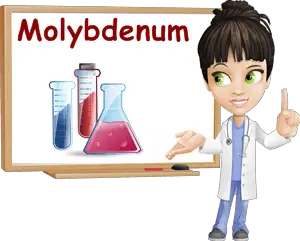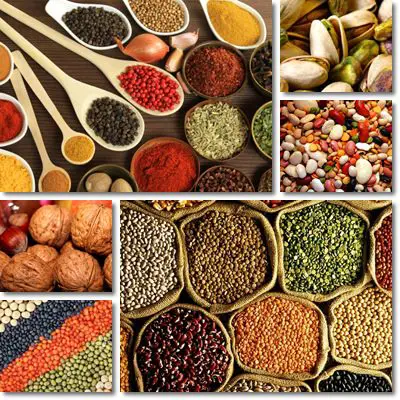Although it is less popular than its fellow minerals, molybdenum is essential for human survival. It is found in plant, animal and human tissue and helps synthesize proteins and mobilize iron reserves. It is a cofactor for more than 50 different enzymes and it is involved in the metabolism of fats and carbohydrates, contributing immensely to improving energy levels and overall good health. A pronounced, continual molybdenum deficiency is believed to increase the risk of esophageal and stomach cancer in particular.
While a deficit can pose serious health risks, ingesting too much molybdenum can be harmful for human health as well. Research suggests the average adult needs about 45 micrograms of the mineral a day, a small requirement one can easily meet by eating foods rich in molybdenum such as legumes and grains. The human body stores molybdenum mostly in the liver and kidneys. Molybdenum deficit and intoxication can thus both cause liver and kidney damage. Other small amounts of the mineral are stored in our tooth enamel and vertebrae.

As far as its biological role is concerned, it helps convert purines into uric acid, a natural by-product of normal metabolic processes. Uric acid has antioxidant properties and is believed to maintain healthy blood vessels. It has been theorized that a severe, prolonged deficiency of molybdenum can increase the risk for both stomach and esophageal cancer, as revealed by research on Chinese, South African and Indian populations. For example, studies connect a higher incidence of esophageal cancer in individuals with low intakes of both molybdenum and zinc (The Levels of Zinc and Molybdenum in Hair and Food Grain in Areas of High and Low Incidence of Esophageal Cancer: A Comparative Study). A low presence of the two minerals has been observed in both the hair of sufferers and in grains from the area, grains being an important source of the nutrients.
Moreover, molybdenum is believed to promote longevity in humans. Research on Chinese populations shows a higher presence of molybdenum and other elements such as calcium or zinc in the soil in regions where inhabitants have long lifespans, suggesting that minerals available naturally in the soil can positively influence longevity (Relationships between distributions of longevous population and trace elements in the agricultural ecosystem of Rugao County, Jiangsu, China).
Molybdenum can be found both in animal products and plants, but the quantity depends immensely on the soil in which the plants are grown, either for human or animal consumption. Chicken and beef liver and kidneys, peas, beans, peanuts and grains in general are all good dietary sources of molybdenum, and so is water. Nevertheless, the amounts of the mineral may differ greatly within the same type of food due to soil specificity. For example, rice grown in certain parts of China can be rich in molybdenum if the soil is already rich in it, while rice grown in other parts where the soil is naturally low in the mineral is more likely to be very low in molybdenum, causing inhabitants or others who consumed it to be prone to a deficiency.

While it may not be encouraging to know that soil dictates just how much molybdenum our food will have, the advantage is we need very little of it (an average adult does fine with a minimum daily recommended intake of about 45 micrograms). Specialists thus feel there should be no reason to rely on supplements, unless otherwise recommended by your doctor. Too much molybdenum, which we can only get from supplements, can increase the amount of copper our body eliminates, encouraging a deficiency. Research reveals the two minerals work in a fragile balance and too much or too little of one can affect the way our body makes use of the other.
However, like in the case of any other nutrient, molybdenum deficiency can occur, although it is a rare condition, occurring mostly in parts of the world where the soil in naturally low in the mineral. A poor diet, geographical differences in soil concentrations and specific medical conditions may cause a shortage of the mineral.
Molybdenum deficiency symptoms
What are the symptoms of molybdenum deficiency? Tooth decay, premature aging, low fertility in men, anemia, growth retardation, palpitations, fast heart rate, neurological problems, headaches, vision disturbances, even autism are all believed to be caused by a pronounced molybdenum deficit.
Molybdenum toxicity symptoms
At the same time, intoxication with the mineral can lead to kidney and liver damage, diarrhea, growth impairment and gout (due to an excess of uric acid caused by a high purine intake). This is why taking molybdenum food supplements can be dangerous, because overdosing may occur easily. Another intoxication symptom includes copper deficiency as molybdenum impairs normal copper absorption.
What are the benefits of Molybdenum?
An adequate intake, which is fairly easy to achieve as a result of a varied, balance diet, contributes to a healthy body and a healthy mind. Here are the 7 biggest health benefits of molybdenum:
- It promotes proper metabolic function. This means your metabolism will successfully burn (or synthesize) fats, carbohydrates and proteins from food and turn them into energy.
- Molybdenum supports bone growth, thus ensuring a strong bone frame.
- It strengthens teeth and prevents cavities.
- Because it mobilizes iron in the body, it is believed to help treat anemia.
- Preliminary studies suggest the mineral has anticancer properties.
- It improves general well-being.
- Last but not least, molybdenum helps the body detoxify after alcohol consumption.
Molybdenum absorption rate and cooking losses
About 50-90% of the ingested amounts of the mineral get absorbed at stomach and intestinal level, thus boasting a high absorption rate compared to several other essential nutrients. Moreover, the molybdenum content of foods is not affected by cooking heat, so foods containing it remain equally nutritious following exposure to cooking heat, with no significant loss of the mineral.
